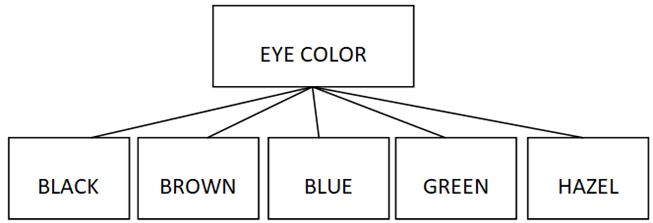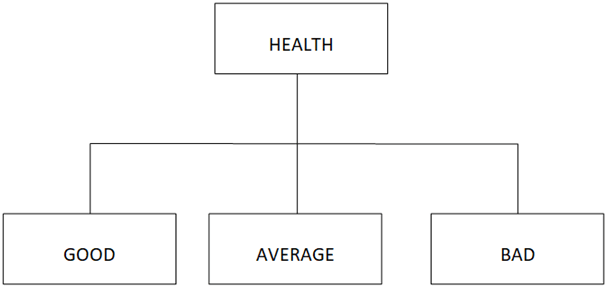This set of Data Mining Multiple Choice Questions & Answers (MCQs) focuses on “Data Objects and Attribute Types – Set 2”.
1. Which of the following attribute values have a meaningful order but no information about the magnitude between successive values?
a) Nominal
b) Binary
c) Ordinal
d) Numeric
View Answer
Explanation: Ordinal attributes have values that can be ranked or have a meaningful order. But the magnitude of difference between the ordinal attribute values is not known or does not make sense.
2. Which of the following is the primary usage of ordinal attributes?
a) Subjective evaluation of quantities that cannot be measured quantitatively
b) Subjective evaluation of quantities that can be measured quantitatively
c) Qualitative analysis of quantities with no defined ranking
d) Qualitative analysis of quantities with quantitatively measurable difference between them
View Answer
Explanation: Ordinal attributes have values that have a meaningful order but cannot be measured quantitatively. So, the ordinal attributes are used for subjective evaluation of these non-quantifiable values.
3. Which of the following can be appropriately represented as an ordinal attribute?
a) Gender of a student
b) Ratings in a survey
c) Hair color
d) Probability of rain
View Answer
Explanation: The ordinal attribute values are qualitative and thus, have an inherent order, but, are non-quantifiable. Ratings of a survey form one such example where ordinal attributes are used as we cannot measure the magnitude by which one rating is better than the other.
4. Which of the following is not defined for an ordinal attribute?
a) Mean
b) Median
c) Mode
d) Equality
View Answer
Explanation: Due to ordinal attributes being qualitative, some of the central tendency measures are not defined for it. Though we can calculate median, which is the middle value of the sequence, and mode, which is the most common value, for an ordinal attribute, arithmetic mean makes no sense and is not defined.
5. Which of the following attribute type is considered the most appropriate by psychologists to represent cognitive and other abilities?
a) Ordinal
b) Numeric
c) Nominal
d) Ratio scale
View Answer
Explanation: Ordinal attribute values have a meaningful order but are not quantifiable. Since the cognitive and other abilities, when measured, are mostly used for comparisons and some of these measurements do not have an absolute zero, they are best represented by ordinal attributes.
6. The attribute type with values that are measurable quantities represented by integers or real values is called as _____
a) Nominal
b) Binary
c) Numeric
d) Ordinal
View Answer
Explanation: The numeric attribute values are measurable quantities and hence, quantifiable. These values are represented by either integers or real numbers, according to the situation the variable represents.
7. The interval-scaled attributes have values that can be ranked and the magnitude of difference between the values is _____
a) Quantifiable
b) Non-quantifiable
c) Not defined
d) Subjective
View Answer
Explanation: The numeric attributes can be either interval-scaled or ratio-scaled. The interval-scaled numeric attributes have can be ranked as well as the magnitude of difference between their values can be calculated.
8. Which of the following is not defined for interval-scaled attribute values?
a) Arithmetic mean
b) Median
c) Standard deviation
d) Ratio
View Answer
Explanation: The interval-scaled attribute values are quantifiable due to which measures of central tendency like mean, median and mode are defined. Measures of statistics like range and standard deviation are also allowed. But due to the absence of a well defined zero-point, ratios are not allowed.
9. Which of the following cannot be represented as an interval-scaled attribute?
a) Celsius temperature scale
b) Fahrenheit temperature scale
c) Kelvin temperature scale
d) Calendar dates from an arbitrary point
View Answer
Explanation: Interval-scaled attribute values do not have a well defined zero-point. The Kelvin temperature scale has a well defined zero, which is zero Kelvin, and hence, cannot be represented by interval-scaled attributes.
10. Which of the following attributes are also known as scaled attributes?
a) Ordinal
b) Nominal
c) Interval-scaled
d) Ratio-scaled
View Answer
Explanation: The interval-scaled attributes have values that can be ranked as well as the difference between the values is a measurable quantity. These attributes are measured on a scale of equal size partitions or units and are known as scaled variables.
11. Which of the following can be appropriately represented as a ratio-scaled attribute?
a) A point in Cartesian coordinates
b) Direction in degrees measured from South Pole
c) Intelligence Quotient score
d) Mass
View Answer
Explanation: Ratio-scaled attribute values can be ranked and a zero-point is defined. Locations in Cartesian coordinates, direction in degrees measured from South Pole, intelligence quotient (IQ) scores, are some of the examples of interval-scaled attributes. Mass, on the other hand, is best represented by a ratio-scaled attribute.
12. Which of the following is true about ratio-scaled variables?
a) Harmonic mean is not defined
b) Geometric mean is not defined
c) Co-efficient of variation is not defined
d) All statistical measures are defined
View Answer
Explanation: Ratio-scaled attribute values have a well defined zero-point. Due to this, ratio is defined for ratio-scaled attributes. Arithmetic mean, harmonic mean, geometric mean, median, mode, and all statistical measures are defined.
13. Which of the following cannot be appropriately represented as a continuous attribute?
a) Height
b) Weight
c) Time
d) ZIP codes
View Answer
Explanation: Continuous attributes can have an infinite set of values. Height, weight, time are represented as continuous attributes. ZIP codes, on the other hand, are best represented as a discrete attribute due to their values being in one-to-one correspondence with natural numbers.
14. Which of the following attribute type is most appropriate to represent the situation given in the diagram below?

a) Nominal
b) Ordinal
c) Numeric
d) Binary
View Answer
Explanation: The diagram depicts different varieties of eye colors found in the population. The black, brown, blue, green, hazel, are just the names or categories and not quantifiable values. Also, they cannot be ranked and hence, are best represented as values of a nominal attribute.
15. Which of the following attribute type best represents the diagram given below?

a) Numeric
b) Ordinal
c) Nominal
d) Binary
View Answer
Explanation: The diagram gives the different states of health a person can identify with. Each state is subjectively comparable to the other. Good is better than average which is better than bad. Thus, ranking is meaningful but the value by which good is better than average is not known. Hence, the situation is aptly represented by an ordinal attribute.
Sanfoundry Global Education & Learning Series – Data Mining.
To practice all areas of Data Mining, here is complete set of Multiple Choice Questions and Answers.
If you find a mistake in question / option / answer, kindly take a screenshot and email to [email protected]
